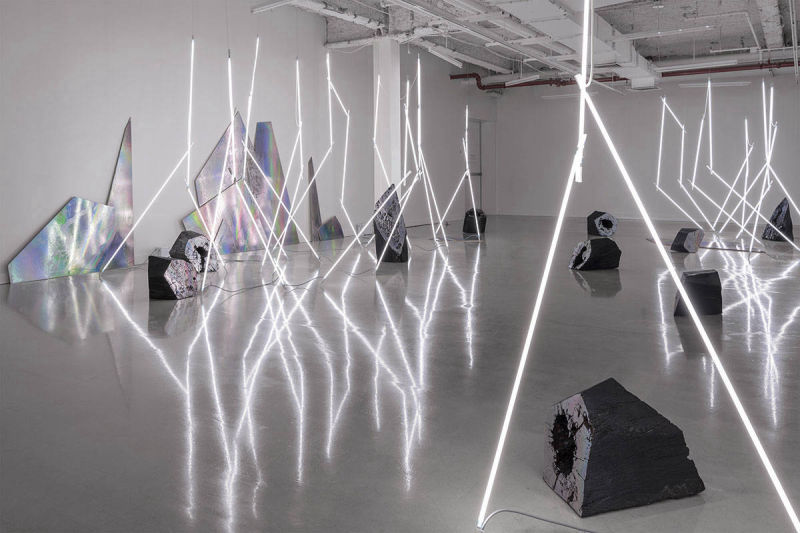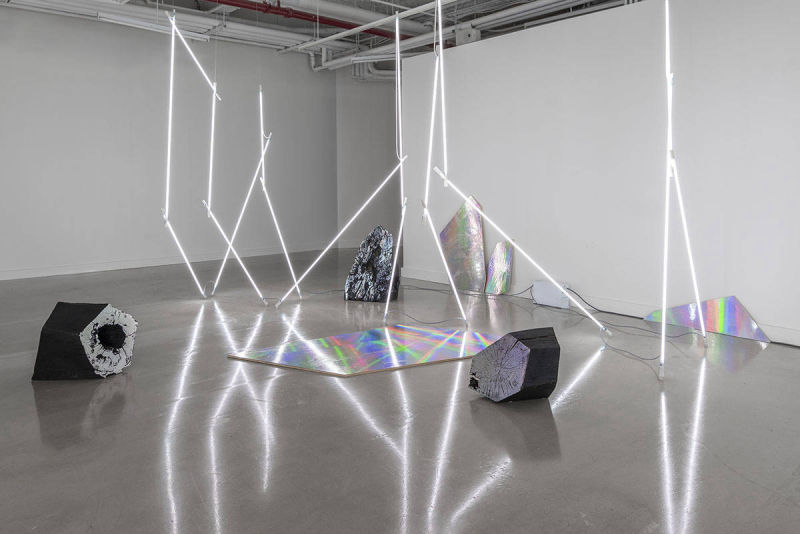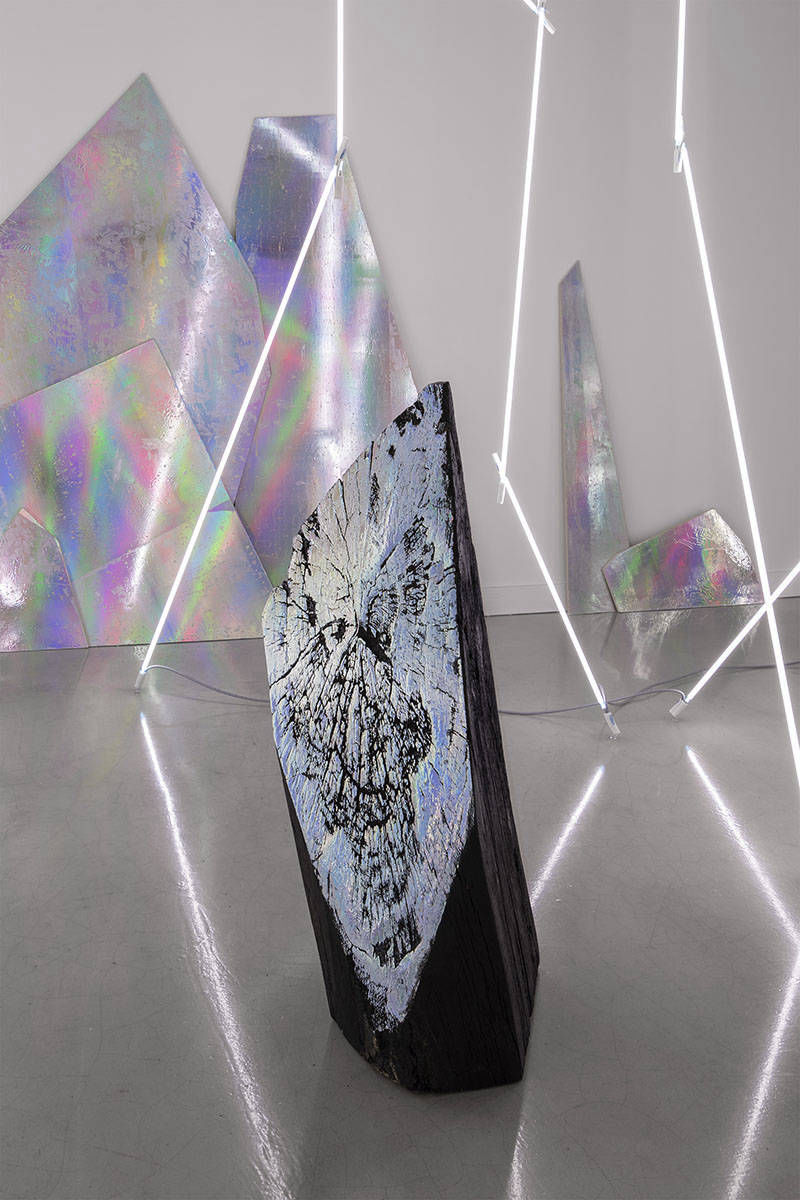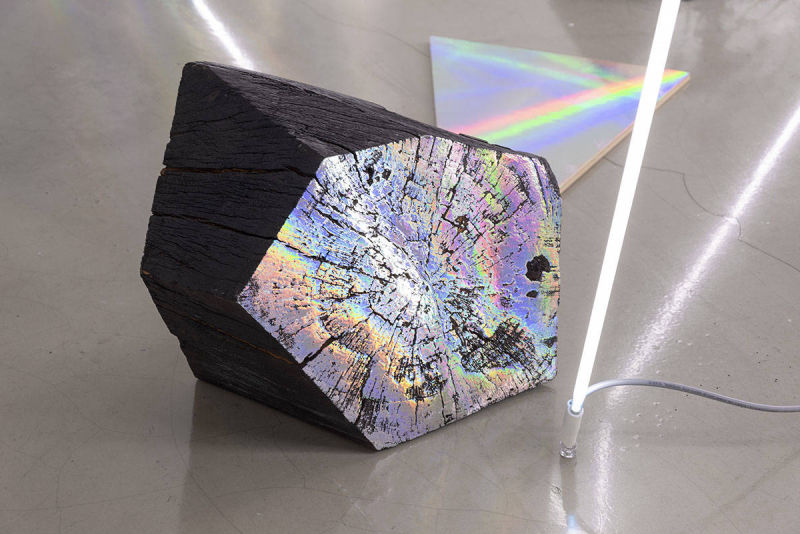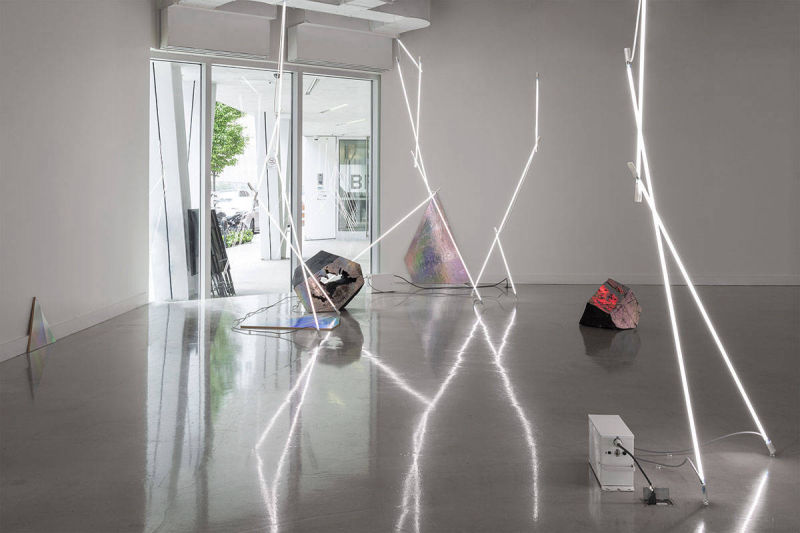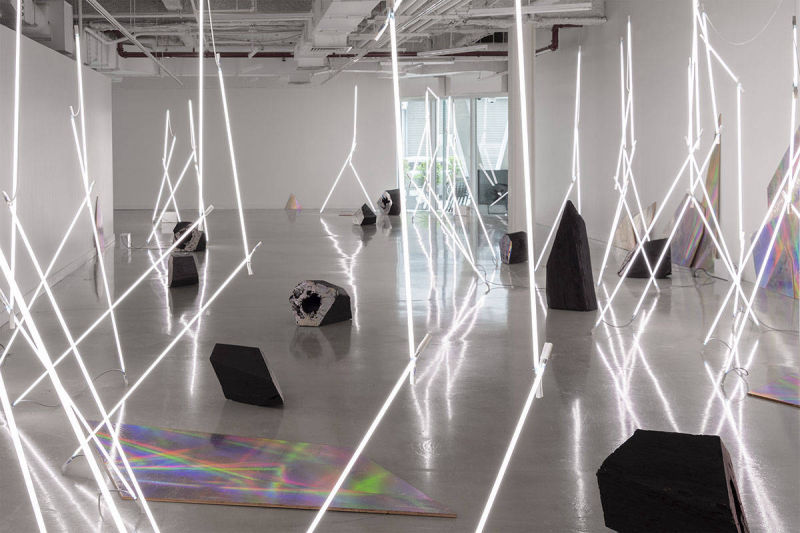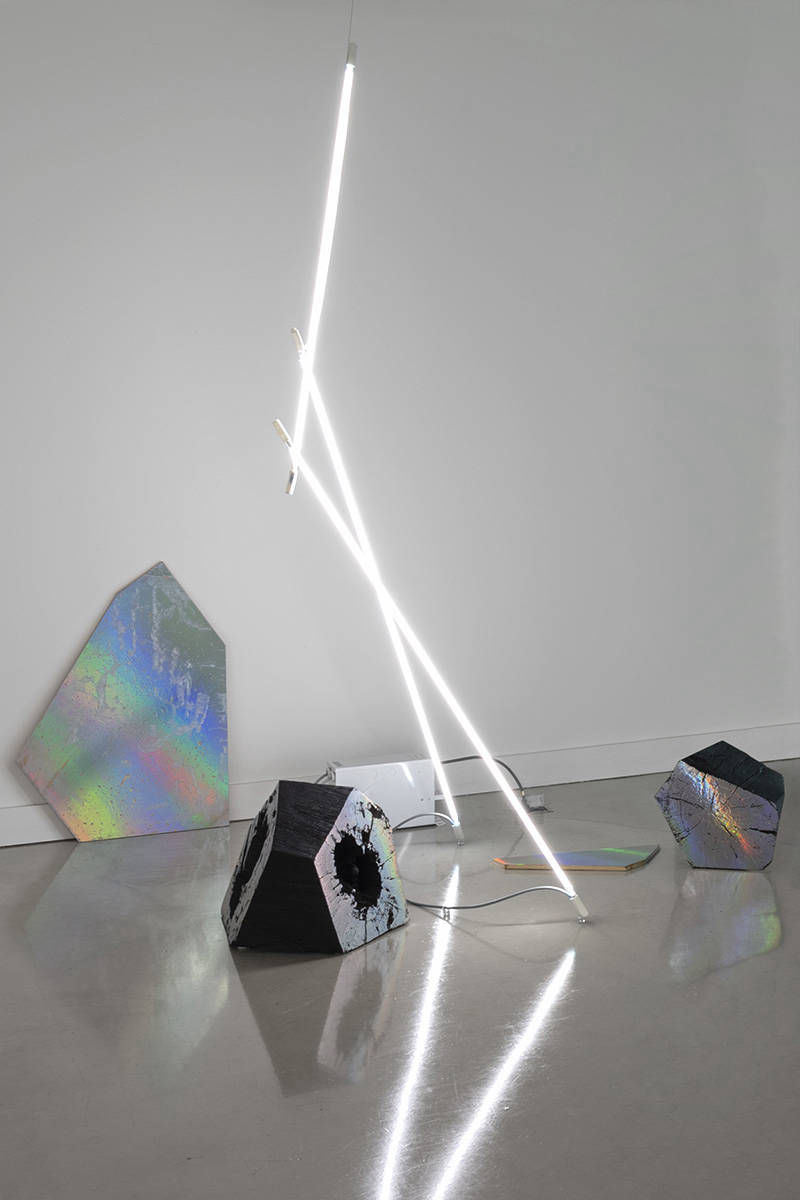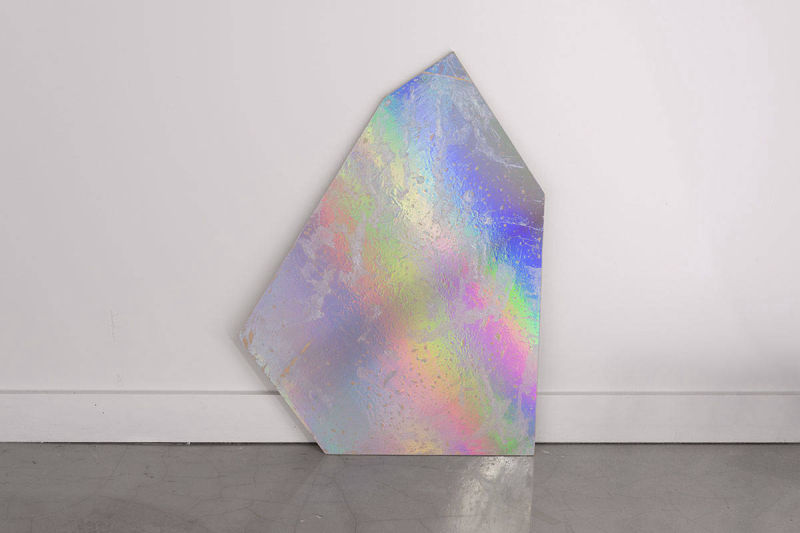Keith Lemley: More is Different
By Heather Bhandari and Courtney Colman, The Remix
“One teacup of empty space contains enough energy to boil all the world’s oceans.”
—Richard Feynman
Keith Lemley is an artist with the heart and mind of a scientist; he is curious, constantly experimenting, and endlessly fascinated with the unknown and unseen. In the exhibition More Is Different, he visualizes the scientific principles of emergent phenomena and broken symmetry through an installation of neon and wood. In doing so, he awakens our innate fascination with nature and the realization that everything and everyone is connected despite myriad differences.
For many children, nature offers an escape into the imagination. Stumps are thrones, flying carpets, and dining tables. The sky is home to aliens, spaceships, gods, and monsters. Lightning is magic. As we age, we learn about origin, chemistry, physics, and utility. The magic is slowly explained and, for some, it disappears into the monotony of the everyday. For artists and scientists, explanations often elicit more questions and deeper research. Discoveries lead to bigger mysteries, more purposeful investigations, and stronger beliefs in unseen connections and possibilities.
Keith Lemley is known for large-scale, angular neon installations that transform spaces into otherworldly environments with light, color, and line. His use of neon is purposeful, and entirely fitting. The materials reference the evanescence of natural events, such as lightning strikes and their immediate afterglow. Additionally, Lemley’s works often visualize fractures in the universe itself—the spaces where seemingly “nothing” is actually boundless energy. He painstakingly handcrafts the neon fixtures in his studio with a hands-on approach similar to that of a scientist in a laboratory. He is equally fascinated by the chemical compositions of the gases and the visual effects they create. It is easy to see Lemley’s artworks as an alchemy of sorts: providing visual structure to the otherwise intangible.
In recent years, Lemley’s practice expanded to include natural elements that work in tandem with neon. First working with wood, he then began working with hand-bent neon tubes on geometrically carved marble sculptures for his 2018 exhibition Deep Time at LMAKgallery. Marble, similar to wood, contains surface veins and fissures. These naturally occurring idiosyncrasies, in combination with the marble’s angular planes, reference the formation of the rock itself over time, as well as the formation of the universe through deep time. Marble acts in opposition to the light emanating from the neon tubes. The weighty, sculptural floor elements are rooted in earthly materials, while the neon’s atmospheric glow is both weightless and extraterrestrial.
Lemley returns to using wood for More is Different. Inspired by a chance encounter with a charred tree stump on a long walk near his studio in West Virginia, his new installation brings together neon, burnt wood, and holographic effects to recreate the wonder of scholarly scientific investigation and childlike exploration. The resulting translation of this experience utilizes clusters of glass tubes shooting out from blackened tree stumps, extending from floor to ceiling. Light bounces off the holographic surfaces of the stumps in a rainbow sheen. The whole universe is captured in the cross-section of a tree.
According to some physicists, everything was symmetrical in the first few seconds the universe came into being. Then, due to rapid cooling or other, unknown phenomena, hairline fractures appeared, creating cracks—now referred to as cosmic strings—in the fabric of the universe. By transforming the gallery into a “forest” of neon and wood, Lemley references the cracks in the universe and the galaxy-sized voids they created, each full of infinite energy. The natural materials he employs provide windows into the intricacies of all universal systems: a simple crack in the wood represents the vastness of space and time; fissures zigzagging across regularly spaced growth rings represent broken symmetry in the cosmos; neon light fills emptiness with a palpable presence. When Lemley burns the wood and watches the cracks expand, it conjures images of that moment when the cosmic strings formed. There is disorder within order and the vast darkness of the stump’s central core is anything but an empty space. Nothing in Lemley’s work is devoid of meaning or matter.
The title More Is Different references Philip Warren Anderson’s renowned 1972 article, “More is Different: Broken Systems and the Nature of the Hierarchical Structure of Science,” in which Anderson discusses emergent phenomena and explains why rules applied to individual components within a system cannot necessarily be applied to the larger system. “Emergence occurs when an entity is observed to have properties its parts do not have on their own. These properties or behaviors emerge only when the parts interact in a wider whole.” This is why the wind blowing across the Sahara does not create identically rippled sand dunes or falling snowflakes do not crystallize into matching patterns. It is, perhaps, a scientific explanation for uniqueness, as well as the acknowledgement that all uniqueness exists within a larger, interconnected web. It is also the very premise of installation art.
Lemley is deeply interested in connecting disparate materials and parts of the universe through underlying geometry and theory. In every installation, viewers are given freedom to contemplate what they know from personal, lived experience and what they can only attempt to grasp because it is beyond perception. His motivation is the scientific—but also utopian—idea that there is a unifying structure that joins all thought and matter, past and present. On a literal level, when viewers enter one of his installations, they are bathed in light, becoming a part of the installation itself. On a deeper level, the synthesis of materials points to a common ground uniting media and viewers with one another. During a time of deep and raw divisions among people, it is comforting to remember that everything and everyone is connected.
About the Artist:
Keith Lemley received his MFA from the University of Wisconsin, Madison, in 2010. Since then he has had solo exhibitions every year at venues including LMAKgallery (NYC); Mixed Greens (NYC); 1708 Gallery (Richmond, VA); The Sculpture Center (Cleveland, OH); Redux Contemporary Art Center (Charleston, SC); The Soap Factory (Minneapolis, MN); the Urban Institute for Contemporary Art (Grand Rapids, MI); Complexe Guy Favreau (Montreal, Canada); Summerhall (Edinburgh, United Kingdom); Smith Center for the Arts (Providence, RI); UW-Milwaukee Union Art Gallery (Milwaukee, WI); ROY G BIV Gallery (Columbus, OH); and Pittsburgh Center for the Arts (Pittsburgh, PA). Group exhibition venues include the Museum of Modern Art (NYC); Family Business (NYC); Dowd Gallery (Cortland, NY); Trestle Gallery (Brooklyn, NY); Los Angeles Center for Digital Art (Los Angeles, CA); Shoshana Wayne (Santa Monica, CA); Glazenhuis National Museum (Lommel, Belgium); Dubuque Museum of Art (Dubuque, IA); Exhibit A (Corning, NY); Parlor Gallery (Asbury Park, NJ); and the Dishman Art Museum (Beaumont, TX). He splits his time between Ohio and West Virginia.
About the Curators:
Heather Bhandari is an independent curator, co-founder of The Remix, and the Creative Director of the Art World Conference (a new business and financial literacy conference for visual artists that debuted in New York in April). She is also an adjunct lecturer at Brown University where she teaches professional practice. The second edition of her book, ART/WORK, was published by Simon and Schuster in October of 2017. Bhandari is on the board of directors of visual arts at Art Omi (an artist residency in Ghent, NY) and the advisory boards of CODIFY Art (a multidisciplinary collective of QTPOC artists) and Trestle Gallery in Brooklyn. From 2000 to 2016 she was a director of Mixed Greens, a commercial gallery where she curated well over one hundred exhibitions while managing a roster of nearly two-dozen emerging to mid-career artists. Most recently, she was the Director of Exhibitions at Smack Mellon, a nonprofit in Brooklyn. Bhandari received a BA from Brown University and an MFA from Pennsylvania State University. Her career began at contemporary galleries Sonnabend and Lehmann Maupin.
Courtney Colman is an art advisor, curator, and co-founder of The Remix. She is the founder of Colman Art Advisory. In 2015, she was named by the San Francisco Chronicle as being a member of “S.F.’s New Art Guard: 5 Women Curating the City.” From 2005 to 2013 she was the Exhibitions Coordinator of Mixed Greens gallery (New York City). She previously taught as an adjunct instructor at FIT (New York City), and has served as a portfolio reviewer for RISD, NURTUREArt, and the American Society of Media Photographers. She currently serves on the advisory board of Projex Connect (San Francisco). Colman received a BA in Art History from Wellesley College and an MA in Art Market Practices from FIT. Her career began at the Peggy Guggenheim Collection in Venice, Italy.
